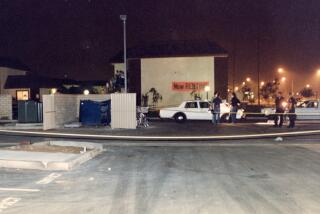Defense Challenges DNA as Trial Begins in Runnion Killing
- Share via
The long-awaited trial of a Lake Elsinore man accused of kidnapping and killing 5-year-old Samantha Runnion started Monday with a hearing to determine if defense-challenged DNA evidence pulled from under the child’s fingernails can be included.
Lawyers for Alejandro Avila, 29, have challenged the DNA testing methods sheriff’s investigators used, saying they were unproven.
Orange County prosecutors contend that the types of DNA to be used at trial -- DNA that has been used in the scientific community for decades but are still rare in the legal world -- are scientifically valid. One of the types, taken from outside a cell’s nucleus and called mitochondrial DNA, was used in the Scott Peterson murder trial.
“It’s nothing new or different,” Assistant Dist. Atty. David Brent said outside court. “Science is progressing every day, and they are always coming up with new and better ways of looking at evidence, at smaller pieces of evidence.”
The hearing is scheduled to continue Jan. 10 in Judge William R. Froeberg’s Santa Ana courtroom and is expected to last two more weeks. After the judge determines whether the evidence can be used, Avila’s attorneys will present their case for moving the trial to a different county. If the case stays in Orange County, jury selection could begin in late January.
Samantha was kidnapped July 15, 2002, outside the Stanton condominium complex where her family lives. Her body was found the next day in the Santa Ana Mountains, a few miles from Avila’s apartment.
Prosecutors are seeking the death penalty for Avila, who has pleaded not guilty.
Most of the documents relating to Avila’s case have been sealed, and both Brent and the defense attorneys have declined to detail the evidence. Avila waived his right to a preliminary hearing.
The DNA hearing is providing a window into some of the previously undisclosed evidence, such as scrapings taken from Samantha’s left hand.
Mitochondrial DNA evidence tends to show that a person linked to the sample cannot be ruled out as its source.
“Neither individual can be excluded as being the sources of this mixed profile,” said Orange County sheriff’s forensic scientist Edward Buse, referring both to Samantha and Avila.
In other cases in which mitochondrial DNA has been used, defense attorneys have contended that it can be contaminated and that people can be wrongly linked to samples.
In questions to Buse, Monday’s only witness, one of Avila’s lawyers raised doubts about the effects of mutations within a DNA sequence and lab accreditation policies.
“No lab has ever lost its accreditation, no matter what it’s done?” Assistant Public Defender Phil Zalewski asked Buse.
The scientist replied that he did not know of any, but had heard of some labs being placed on probation for having “major problems.”
Zalewski pressed him, asking him about what happened to the FBI’s DNA lab after one of its employees admitted falsifying results this year. Prosecutors objected to the question, and Buse did not answer.
More to Read
Sign up for Essential California
The most important California stories and recommendations in your inbox every morning.
You may occasionally receive promotional content from the Los Angeles Times.













